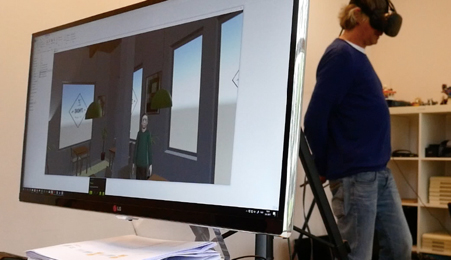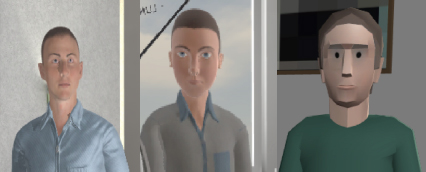13 December 2017
IJsfontein and the eGGZ center of ARQ join forces. Together we developed a VR environment that allows people with depression to practice breaking their negative thought patterns.
How does it work?
You can view the experience as a practice environment, a ‘wading pool’ of sorts, to start working on the therapist’s lessons. Under guidance, the patient enters a virtual environment to look for tense situations, get on the wrong thought track and then gradually get his or her thoughts under control.
Why VR?
Anyone who has ever had a pair of VR glasses on can tell you; you really step into another world. While you are still aware that it is not the real world. The VR world thus makes the step from theory you have learned in the therapy, to applying it in the real world, smaller.
One of the healthy testers of the VR environment. The therapist can watch on a screen what the tester sees in the glasses while he walks and looks around.
You are the waiter – and they are laughing at you.
Under the guidance of the therapist, you step into the VR world. Here you are a waiter in a small lunch shop and you play short scenes that are inherent to being a waiter. You are faced with two ladies who burst out laughing while they order a coffee from you. What are you thinking?
Characteristic of depression is that such an incident can conjure up a spiraling thought cycle; “If they laugh at me they think I’m stupid, if I’m stupid I can’t do my job, then I’ll be fired, then I won’t have any money etc”. The aim of the game is to stimulate the player to allow other thoughts in and to break the cycle. This is based on cognitive behavioural therapy, the most commonly used method for treatment of depression.
Do you agree with this idea?
The use of this VR experience is twofold. On the one hand you are confronted with your own ‘thinking errors’, because you end up in a certain situation that generates a certain thought. Just like the aforementioned laughing ladies with their coffee order. On the other hand, we also use the VR environment as a (low-threshold) observation exercise. You can ‘listen in’ on the thoughts of different people in the café. For example, a guy sitting in front of a laptop screen thinks: ‘I can’t get a single word to paper, they probably think I’m good-for-nothing’
Then the computer asks the question “Do you agree with his conclusion?” The clients task is to devise alternative conclusions for this virtual character. Alternative conclusions such as ‘nobody sees it’ or even more positive ‘they think I have a difficult job to do’. Alternating between observing and experiencing helps clients to feel more comfortable.
Can the therapist then just sit back?
No, it doesn’t work that way. The therapist has a crucial role in this VR experience. He or she can actually influence what situations the client is faced with, determine when the computer asks the player questions and controls the buttons that encourage the player to think of alternative thoughts. Behind a PC the therapist watches what the client is experiencing and directs/edits that experience. This allows the therapist to stimulate every client to take the next step at their own level. A balance that a computer (for now) cannot determine.
The devil is in the detail
In order to make the script and design so that it activates the characteristic circle of thoughts with as many people as possible, testing is essential. Of course, a therapist is always involved in these tests. It turns out that details make the difference in this project. Through trial and error we scan the small nuances and differences. We test with healthy people, people who have been depressed and people who are currently in treatment for their depression.
Realistic or abstract?
Contrary to what you might expect, research into various visual media, including VR, shows that an abstract visual style can work just as well (or better) in releasing emotions as a realistic style. Experimentation with different styles was therefore done at an early stage. People viewed the VR world in style A, B and C (see image). The last, most abstract style seemed to resonate much stronger. One tester said: “because you do not see someone’s facial expression, you are more likely to interpret one yourself”. As a result, a neutral situation can suddenly get a negative intonation. “That is exactly what we want to trigger in a patient so we can teach the patient how to handle the situation.” said one of the practitioners working on this project.
A: realistic B: cartoony C: abstract
Images from the test with different styles (the A, B, C test) in order to research what is needed for ‘emotional commitment’.
VR in Health
What could you do with VR? We have seen and now also developed many VR experiences. Use VR if you want your target audience to experience something that:
- Is dangerous in real life
- Is invisible in real life
- Is very expensive and/or take a lot of time in real life
- Is in need of individual attention, guidance and feedback
- Will take place at a different time and/or place
- Is about speed, height or the sensation of flight
- Can be better understood through a different perspective (micro or macro)
- Is all about total emersion into an emotion
- stimulates in relation to a rare situation
What’s next
The potential of Virtual Reality for therapeutic purposes is becoming more and more apparent. Think of the use of VR to get rid of fears, such as fear of heights, confined spaces, groups of people and flying. The first results of research into the use of VR for the treatment of PTSD are encouraging (Erasmus University and Delft University of Technology, among others, are researching this).
VR is used as part of ‘exposure therapy’ where the big advantage in its use is that the situation and the intensity of the exposure is completely controlled, allowing someone to practice controlling a panic attack or loss of temper, at their own pace. Other applications that we are currently working on are in the field of meditation, stress reduction and pain experience.
Would you like to contribute your thoughts as a practitioner?
We are looking for practitioners who would like to think about the training and implementation needs for the application. Interested? Send an email to iris@ijsfontein.nl


